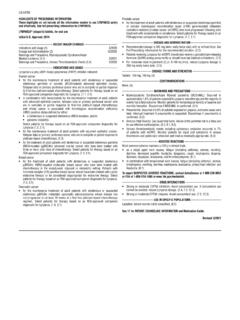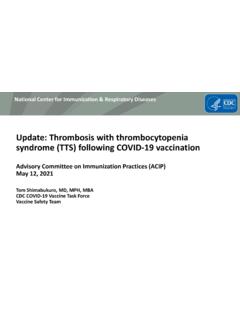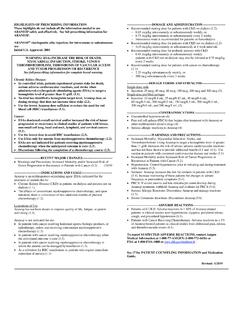Transcription of ANNEX I SUMMARY OF PRODUCT CHARACTERISTICS
1 1 ANNEX I SUMMARY OF PRODUCT CHARACTERISTICS 2 1. NAME OF THE MEDICINAL PRODUCT Eylea 40 mg/mL solution for injection in pre-filled syringe. 2. QUALITATIVE AND QUANTITATIVE COMPOSITION 1 mL solution for injection contains 40 mg aflibercept*. One pre-filled syringe contains an extractable volume of at least mL, equivalent to at least mg aflibercept. This provides a usable amount to deliver a single dose of mL containing 2 mg aflibercept. *Fusion protein consisting of portions of human VEGF (Vascular Endothelial Growth Factor) receptors 1 and 2 extracellular domains fused to the Fc portion of human IgG1 and produced in Chinese hamster ovary (CHO) K1 cells by recombinant DNA technology.
2 For the full list of excipients, see section 3. PHARMACEUTICAL FORM Solution for injection (injection) The solution is a clear, colourless to pale yellow and iso-osmotic solution. 4. CLINICAL PARTICULARS Therapeutic indications Eylea is indicated for adults for the treatment of neovascular (wet) age-related macular degeneration (AMD) (see section ), visual impairment due to macular oedema secondary to retinal vein occlusion (branch RVO or central RVO) (see section ), visual impairment due to diabetic macular oedema (DME) (see section ), visual impairment due to myopic choroidal neovascularisation (myopic CNV) (see section ). Posology and method of administration Eylea is for intravitreal injection only.
3 Eylea must only be administered by a qualified physician experienced in administering intravitreal injections. Posology wet AMD The recommended dose for Eylea is 2 mg aflibercept, equivalent to mL. Eylea treatment is initiated with one injection per month for three consecutive doses. The treatment interval is then extended to two months. Based on the physician s judgement of visual and/or anatomic outcomes, the treatment interval may be maintained at two months or further extended using a treat-and-extend dosing regimen, where 3 injection intervals are increased in 2- or 4-weekly increments to maintain stable visual and/or anatomic outcomes. If visual and/or anatomic outcomes deteriorate, the treatment interval should be shortened accordingly.
4 There is no requirement for monitoring between injections. Based on the physician s judgement the schedule of monitoring visits may be more frequent than the injection visits. Treatment intervals greater than four months or shorter than 4 weeks between injections have not been studied (see section ). Macular oedema secondary to RVO (branch RVO or central RVO) The recommended dose for Eylea is 2 mg aflibercept equivalent to mL. After the initial injection, treatment is given monthly. The interval between two doses should not be shorter than one month. If visual and anatomic outcomes indicate that the patient is not benefiting from continued treatment, Eylea should be discontinued. Monthly treatment continues until maximum visual acuity is achieved and/or there are no signs of disease activity.
5 Three or more consecutive, monthly injections may be needed. Treatment may then be continued with a treat-and-extend regimen with gradually increased treatment intervals to maintain stable visual and/or anatomic outcomes, however there are insufficient data to conclude on the length of these intervals. If visual and/or anatomic outcomes deteriorate, the treatment interval should be shortened accordingly. The monitoring and treatment schedule should be determined by the treating physician based on the individual patient s response. Monitoring for disease activity may include clinical examination, functional testing or imaging techniques ( optical coherence tomography or fluorescein angiography).
6 Diabetic macular oedema The recommended dose for Eylea is 2 mg aflibercept equivalent to mL. Eylea treatment is initiated with one injection per month for five consecutive doses, followed by one injection every two months. There is no requirement for monitoring between injections. After the first 12 months of treatment with Eylea, and based on the physician s judgement of visual and/or anatomic outcomes, the treatment interval may be extended, such as with a treat-and-extend dosing regimen, where the treatment intervals are usually increased by 2-week increments to maintain stable visual and/or anatomic outcomes. There are limited data for treatment intervals longer than 4 months. If visual and/or anatomic outcomes deteriorate, the treatment interval should be shortened accordingly.
7 The schedule for monitoring should therefore be determined by the treating physician and may be more frequent than the schedule of injections. If visual and anatomic outcomes indicate that the patient is not benefiting from continued treatment, Eylea should be discontinued. Treatment intervals shorter than 4 weeks between injections have not been studied (see section ). 4 Myopic choroidal neovascularisation The recommended dose for Eylea is a single intravitreal injection of 2 mg aflibercept equivalent to mL. Additional doses may be administered if visual and/or anatomic outcomes indicate that the disease persists. Recurrences should be treated as a new manifestation of the disease .
8 The schedule for monitoring should be determined by the treating physician. The interval between two doses should not be shorter than one month. Special populations Hepatic and/or renal impairment No specific studies in patients with hepatic and/or renal impairment have been conducted with Eylea. Available data do not suggest a need for a dose adjustment with Eylea in these patients (see section ). Elderly population No special considerations are needed. There is limited experience in patients older than 75 years with DME. Paediatric population The safety and efficacy of Eylea have not been established in children and adolescents. There is no relevant use of Eylea in the paediatric population for the indications of wet AMD, CRVO, BRVO, DME and myopic CNV.
9 Method of administration Intravitreal injections must be carried out according to medical standards and applicable guidelines by a qualified physician experienced in administering intravitreal injections. In general, adequate anaesthesia and asepsis, including topical broad spectrum microbicide ( povidone iodine applied to the periocular skin, eyelid and ocular surface), have to be ensured. Surgical hand disinfection, sterile gloves, a sterile drape, and a sterile eyelid speculum (or equivalent) are recommended. The injection needle should be inserted mm posterior to the limbus into the vitreous cavity, avoiding the horizontal meridian and aiming towards the centre of the globe. The injection volume of mL is then delivered; a different scleral site should be used for subsequent injections.
10 Immediately following the intravitreal injection, patients should be monitored for elevation in intraocular pressure. Appropriate monitoring may consist of a check for perfusion of the optic nerve head or tonometry. If required, sterile equipment for paracentesis should be available. Following intravitreal injection patients should be instructed to report any symptoms suggestive of endophthalmitis ( eye pain, redness of the eye, photophobia, blurring of vision) without delay. Each pre-filled syringe should only be used for the treatment of a single eye. Extraction of multiple doses from a pre-filled syringe may increase the risk of contamination and subsequent infection. The pre-filled syringe contains more than the recommended dose of 2 mg aflibercept (equivalent to mL solution for injection).














